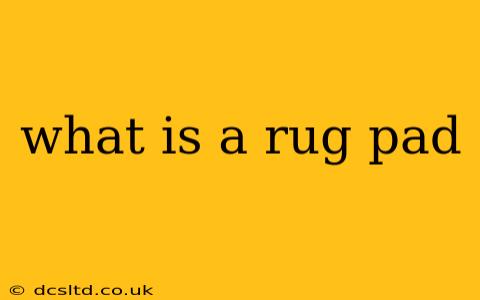A rug pad, also known as a rug underlay or carpet pad, is a protective layer placed beneath your area rug. It's much more than just a simple piece of padding; it's a crucial element for extending the life of your rug, enhancing its appearance, and protecting your floors. Think of it as the unsung hero of your home's décor, quietly working to keep everything looking and feeling its best.
Why Use a Rug Pad?
The benefits of using a rug pad extend beyond simply making your rug feel softer underfoot. A good quality rug pad provides a multitude of advantages, including:
-
Increased Rug Lifespan: A rug pad acts as a cushion, absorbing the impact of foot traffic and preventing wear and tear on the rug fibers. This is particularly important for rugs in high-traffic areas. It reduces friction, minimizing fraying and shedding.
-
Enhanced Comfort and Softness: Stepping onto a rug with a pad is a noticeably more comfortable experience. The added cushioning makes the rug feel plusher and more luxurious.
-
Improved Rug Appearance: A rug pad helps to prevent wrinkles, bunching, and slipping, keeping your rug looking neat and tidy. It prevents the rug from shifting and bunching up, maintaining its shape and overall aesthetics.
-
Floor Protection: The pad acts as a barrier between your rug and your floor, protecting hardwood, tile, and other surfaces from scratches, dents, and stains. It also absorbs spills and prevents moisture from damaging your floors.
-
Reduced Noise: A rug pad can significantly reduce noise from footfalls, making your home quieter and more peaceful, especially beneficial for upstairs rooms or apartments.
-
Increased Rug Stability: This is particularly important for rugs on smooth, hard floors. A rug pad provides the grip necessary to prevent slipping and sliding, improving safety, especially for those with children or pets.
What Types of Rug Pads Are There?
There's a variety of rug pads available, each designed with different materials and thicknesses to suit various needs and rug types:
-
Felt Pads: These are typically inexpensive and provide a basic level of cushioning and grip. They are a good option for rugs in low-traffic areas.
-
Rubber Pads: These offer excellent grip and are ideal for rugs on hard floors, preventing slipping. They often provide good cushioning as well.
-
Memory Foam Pads: These offer superior cushioning and comfort, ideal for rugs in high-traffic areas or where added softness is desired. They conform to the rug's shape, providing excellent support.
-
Wool Pads: These are natural, durable, and provide good cushioning and moisture absorption. They are often more expensive than synthetic options.
-
Combination Pads: Many pads combine different materials to offer a blend of features, such as rubber for grip and foam for cushioning.
What Material is Best for my Rug?
The best material depends on your specific needs and the type of rug you have. Consider factors such as your flooring type, the level of traffic in the room, and your budget when making your choice. A salesperson at a home goods store can offer personalized recommendations.
How Do I Choose the Right Rug Pad Size?
It's crucial to choose a rug pad that's the correct size for your rug. Ideally, the pad should be slightly smaller than the rug to prevent it from showing around the edges. Avoid using a pad that's too small, as this will defeat the purpose of providing even support and prevent slipping.
What About Rug Grippers?
Rug grippers are different from rug pads. While a rug pad provides cushioning and protection, a rug gripper is primarily designed to prevent slipping and provide better grip on smooth surfaces. They are often thin and less cushioning than a rug pad. Some people use both a rug pad and a gripper for maximum protection and stability.
This guide provides a comprehensive overview of rug pads. Remember, selecting the right rug pad can significantly impact the longevity, appearance, and comfort of your rug, protecting both your flooring and your investment.
